If you are hiking through the woods and you have the feeling something is watching you, there’s a good chance it’s an owl (Strigidae). Owls are stealthy and solitary birds of prey that you might walk right past without noticing.
Read on to learn five fun facts to help you understand these fascinating creatures of the night:
- Because of the shape and the size of their large eyes, owls cannot move their eyes to look around. Instead, they swivel their entire head. Since owls have 14 neck vertebrae (compared to seven in humans), their necks are more flexible. They also have adaptations to their circulatory systems which allow them to rotate their head up 270° without cutting off blood to the brain.
- Female owls tend to be slightly larger than male owls.
- Owls are adept hunters. They have sharp talons, and their colors blend in with their natural surroundings making them hard to spot. They have serrated edges on their feathers that muffle their wing beats to allow for slow, silent flight and the ability to quietly pounce on unsuspecting prey.
- Owls have specialized auditory functions that help provide acoustic information to locate and pursue their prey.
- There are over 200 species of owl. Most of them are nocturnal.
Want to learn more about owls and other local wildlife? Visit one of the Forest Preserves’ six nature centers to talk to a naturalist!

